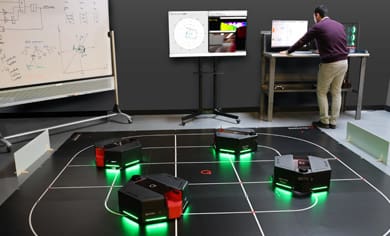
Webinar Details
The human body is capable of dexterous manipulation in many different environments. However, some environments are challenging to access because of the body’s distance, scale, and limitations. In many of these situations, telerobots can effectively restore access. However, dexterous manipulation through these telerobots can only occur when the operator receives sensory feedback from the robot’s environment interactions. In this talk, I will discuss recent work from our lab on applying haptic feedback in the context of telerobotics. First, I will discuss applications of telesurgical robots, upper-extremity prosthetic devices, and fundamental haptic perception. I will then discuss lessons learned from our attempts at haptic interaction design for these applications in a manner applicable to researchers hoping to incorporate haptics into existing research infrastructure.
Presenter’s Bio
Jeremy D. Brown is the John C. Malone Assistant Professor in the Department of Mechanical Engineering at Johns Hopkins University where he directs the Haptics and Medical Robotics (HAMR) Laboratory. He is also a member of the Laboratory for Computational Sensing and Robotics (LCSR) and the Malone Center for Engineering in Healthcare. Prior to joining Hopkins, Jeremy was a Postdoctoral Research Fellow at the University of Pennsylvania in the Haptics Research Group, which is part of Penn’s General Robotics, Automation, Sensing, and Perception (GRASP) Laboratory. He received his M.S. and Ph.D. degrees in Mechanical Engineering at the University of Michigan. He also holds B.S. degrees in Applied Physics and Mechanical Engineering from More house College and the University of Michigan, respectively as a graduate of the Atlanta University Center’s Dual Degree Engineering Program. Brown’s team uses methods from human perception, motor control, neurophysiology, and biomechanics to study the human perception of touch, especially as it relates to applications of human-robot interaction and collaboration. He has been honored to receive several awards including the National Science Foundation (NSF) Graduate Research Fellowship, the Best Student Paper award at the 2012 IEEE Haptics Symposium, the Penn Postdoctoral Fellowship for Academic Diversity, and the NSF CRII Award. He was also recently named a scholar to the NIH funded Interdisciplinary Rehabilitation Engineering Career Development Program (IREK-12). He is a member of the Institute of Electrical and Electronics Engineers’ (IEEE) Robotics and Automation Society, the American Society of Mechanical Engineers (ASME), and the National Society of Black Engineers (NSBE). Brown’s work has appeared in several peer-reviewed journals, including the Journal of Neuroengineering and Rehabilitation, IEEE Transactions on Haptics, IEEE Transactions on Biomedical Engineering, and IEEE Transactions on Neural Systems and Rehabilitation Engineering, and the IEEE Transactions on Medical Robotics and Bionics.




